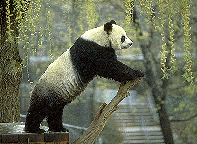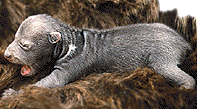|
|
|


![]()
To learn more about bears, please read Ten Facts About Bears or if you want to learn even more, you can go to Amazing Facts About Bears and Books for Young Readers.
After, you can also go to THE BEAR DEN and visit the Photo Gallery.


1. Bears are large animals with thick, strong legs. Bears have big heads, little eyes and small round ears. All bears are covered with heavy fur.

2. Bears can see and hear like us. Bears have a very good sense of smell. Bears can stand on their hind legs to smell and see better. Bears are smart and curious animals.

 3. There are 8 different kinds of bears - brown bears, American black
bears, polar bears, giant panda bears, Asiatic black bears, sloth bears, spectacled bears
and sun bears. Brown bears are also called grizzly bears. Bears live in all parts of the
world, except Africa, Australia and Antarctica.
3. There are 8 different kinds of bears - brown bears, American black
bears, polar bears, giant panda bears, Asiatic black bears, sloth bears, spectacled bears
and sun bears. Brown bears are also called grizzly bears. Bears live in all parts of the
world, except Africa, Australia and Antarctica.

4. Sun bears are the smallest bears. Sun bears live in southeast Asia. They weigh about 45 kilograms (100 pounds). Sun bears are the size of a large dog. Brown bears and polar bears are the biggest bears. They can be over 10 feet long. If a big brown bear or polar bear stands on its hind legs, its head is higher than the ceiling in most houses and classrooms.

5. Most brown bears and American black bears have brown or black fur. Polar bears have white or yellow-white fur. Giant panda bears look very different with their black and white fur. Sun bears, sloth bears and Asiatic black bears often have a white or yellow-white patch on their chest. Spectacled bears have white or yellow-white circles around their eyes. This makes them look like they are wearing eyeglasses or "spectacles".

6. Most bears eat nuts, fruit, berries, plants, insects, honey, fish and other animals. Polar bears eat seals which they catch out on the ice in the Arctic Ocean. Giant panda bears eat the leaves of the bamboo plant. Bears must get big to get ready for winter. To eat as much as a big bear, we would have to eat 50 hamburgers and 12 large orders of french fried potatoes each day for many weeks.

 7. Mother bears can have 1, 2 or 3 cubs. Cubs are about the size of a
small squirrel or chipmunk when born. They grow quickly by feeding on their mother's milk.
They start to eat other foods after a few months. The cubs stay with their mother for a
few years. The mother bear teaches them how to find food and how to stay safe.
7. Mother bears can have 1, 2 or 3 cubs. Cubs are about the size of a
small squirrel or chipmunk when born. They grow quickly by feeding on their mother's milk.
They start to eat other foods after a few months. The cubs stay with their mother for a
few years. The mother bear teaches them how to find food and how to stay safe.

8. Many bears live where the winter is very cold. In these places, bears will find or make a den. They will enter the den when it gets too cold and stay there until spring. This deep sleep is called "hibernation". Bears will not eat or drink during this time. Cubs are born while the mother bear is hibernating.

9. Bears have a few enemies. In North America, bears are sometimes killed by packs of wolves. In Asia, large tigers kill and eat brown bears and Asiatic black bears. Also, male bears will sometimes kill cubs and female bears. People are a bear's biggest enemy. People kill bears for sport. Bears are also killed to get parts of their bodies which are used by some people. Poaching bears is against the law.

10. More bears are dying each year than are being born. Polar bears and American black bears are safe for now. All other kinds of bears need protection. We need to save large areas where bears and other animals can live safely and not be hurt.

Remember, you can also visit these places:

Would You Like to learn ABOUT exotic PETS?
ABOUT knows more ABOUT Exotic Pets

Back to THE BEAR HOMEPAGE
